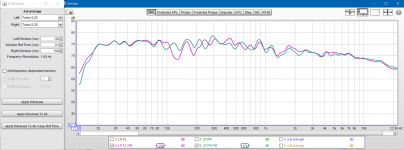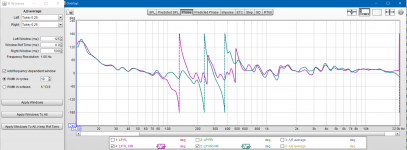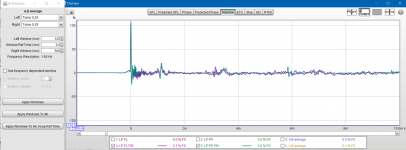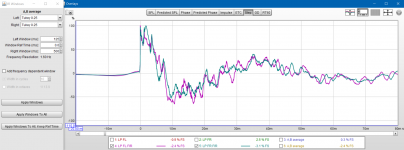Thanks. The examples in the tutorial are not really consistent since they are mixing SwissBear's speakers (most of the graphs on the RePhase part come from his corrections/speakers) and mine (on the Giya), but I think I got your point.
I haven't played with the time offset inside RePhase, and I have been EQ magnitude with linear-phase, so I will now follow your advices and see how this goes.
The phase behavior I get from REW (once the time is adjusted) looks really consistent with the crossover characteristics of the Giyas, and indeed entering the corresponding data in RePhase does most of the phase flattening already. I will post a few graphs tonight.
I guess it would be great to sort this out properly, so that the tutorial doesn't generate more problems than solutions 😉
I haven't played with the time offset inside RePhase, and I have been EQ magnitude with linear-phase, so I will now follow your advices and see how this goes.
The phase behavior I get from REW (once the time is adjusted) looks really consistent with the crossover characteristics of the Giyas, and indeed entering the corresponding data in RePhase does most of the phase flattening already. I will post a few graphs tonight.
I guess it would be great to sort this out properly, so that the tutorial doesn't generate more problems than solutions 😉
I’m a hobbyist that has investigated the REW Step Response (SR) subject. When using REW SR charts it’s helpful to be aware that the REW Step Response (SR) chart does not correct for the soundcard and mic calibrations. Thus the SR chart looks identical whether the 2 correction files are used or not. The SR chart will always reflect the impact of the LF and HF roll-off of the measuring setup as well as the audio measurement. If an audio measurement looks ideal, then there is a deviation from true ideal. The REW SPL and phase charts are properly corrected of course.
A discrepancy in the REW SR chart can thus be misleading. It is helpful to view the SR of a loopback of the measuring system given the same sweep range as will be used for the sound measurements. This may provide a better comfort level regarding some the preringing seen in the sound measurements. If the 2 SR’s look identical then the SR is in reality Ideal, no matter the appearance.
I have observed that using a measurement setup that utilizes a 96k sample rate and wide band response capability of all components in the setup does help to mitigate SR chart discrepancies by moving the low-pass filters further away from the range under test.
Below is my left and right channels at a 4 m listening position using a 96 kHz sample rate. When using a 44.1 or 48 kHz sample rate for measuring, the SR looked more similar to that shown above in Post 1145 (the rePhase trace that was indicated to have excessive preringing). [A 10-cycle FDW is applied to the phase chart below in order to reduce much of the impact of the room.] My near-field measurements (not shown) are as expected with smooth SPL and flat phase including close phase tracking through the 2 kHz and 100 Hz XO’s. [Now if I could just improve my 200-600 Hz room issues. 🙁]
I have concluded that a careful calibration of the entire measuring system allows us to rely on the SPL and phase charts for the proper response. We should not be too concerned if the REW SR chart has apparent preringing. I think this is in support of a comment pos made above.




A discrepancy in the REW SR chart can thus be misleading. It is helpful to view the SR of a loopback of the measuring system given the same sweep range as will be used for the sound measurements. This may provide a better comfort level regarding some the preringing seen in the sound measurements. If the 2 SR’s look identical then the SR is in reality Ideal, no matter the appearance.
I have observed that using a measurement setup that utilizes a 96k sample rate and wide band response capability of all components in the setup does help to mitigate SR chart discrepancies by moving the low-pass filters further away from the range under test.
Below is my left and right channels at a 4 m listening position using a 96 kHz sample rate. When using a 44.1 or 48 kHz sample rate for measuring, the SR looked more similar to that shown above in Post 1145 (the rePhase trace that was indicated to have excessive preringing). [A 10-cycle FDW is applied to the phase chart below in order to reduce much of the impact of the room.] My near-field measurements (not shown) are as expected with smooth SPL and flat phase including close phase tracking through the 2 kHz and 100 Hz XO’s. [Now if I could just improve my 200-600 Hz room issues. 🙁]
I have concluded that a careful calibration of the entire measuring system allows us to rely on the SPL and phase charts for the proper response. We should not be too concerned if the REW SR chart has apparent preringing. I think this is in support of a comment pos made above.




Imho Rephase only issue is the name itself which suggest innocent guys that phase corrections are free lunch.
Remagnitude (the minimum phase way) would be more a serious and less misleading name , but sadly, also less sexy.
Anyway, i think that preringing can be avoided paying more attention to magnitude corrections vs phase corrections.
In other words: Keep your dirty hands out of arbitrary and meaningless phase corrs which only lead to pre ringing!😀
PD: The combination of Holmimpulse measurements and Rephase corrections can be especially nocive owing to Holmimpulse lack of min phase extraction capability. Rephase not bad, simply gives too much freedom and better think twice before applying phase corrs, or applying eqs out of min phase limits.
Remagnitude (the minimum phase way) would be more a serious and less misleading name , but sadly, also less sexy.
Anyway, i think that preringing can be avoided paying more attention to magnitude corrections vs phase corrections.
In other words: Keep your dirty hands out of arbitrary and meaningless phase corrs which only lead to pre ringing!😀
PD: The combination of Holmimpulse measurements and Rephase corrections can be especially nocive owing to Holmimpulse lack of min phase extraction capability. Rephase not bad, simply gives too much freedom and better think twice before applying phase corrs, or applying eqs out of min phase limits.
Last edited:
Good evening,
Just a quick word to confirm that by following POS advise, I have been able to get rid of the pre-ringing, and got an almost perfect STEP this time. The combined speakers response is now very similar to Dirac response !
I was unable to listen tonight but I will report after I do. I would guess it may sound very close now ! 😉
I will have to correct the tutorial to reflect these advise.
Many thanks !
Just a quick word to confirm that by following POS advise, I have been able to get rid of the pre-ringing, and got an almost perfect STEP this time. The combined speakers response is now very similar to Dirac response !
I was unable to listen tonight but I will report after I do. I would guess it may sound very close now ! 😉
I will have to correct the tutorial to reflect these advise.
Many thanks !
hi,technically rephase has the step response thats closest to an actual "flat" response as measured straight out of the preamp
Thanks this is helpful 🙂
Thank you. Can you please detail what you chose as a measurement setting ?I’m a hobbyist that has investigated the REW Step Response (SR) subject. When using REW SR charts it’s helpful to be aware that the REW Step Response (SR) chart does not correct for the soundcard and mic calibrations. Thus the SR chart looks identical whether the 2 correction files are used or not. The SR chart will always reflect the impact of the LF and HF roll-off of the measuring setup as well as the audio measurement. If an audio measurement looks ideal, then there is a deviation from true ideal. The REW SPL and phase charts are properly corrected of course.
A discrepancy in the REW SR chart can thus be misleading. It is helpful to view the SR of a loopback of the measuring system given the same sweep range as will be used for the sound measurements. This may provide a better comfort level regarding some the preringing seen in the sound measurements. If the 2 SR’s look identical then the SR is in reality Ideal, no matter the appearance.
I have observed that using a measurement setup that utilizes a 96k sample rate and wide band response capability of all components in the setup does help to mitigate SR chart discrepancies by moving the low-pass filters further away from the range under test.
Below is my left and right channels at a 4 m listening position using a 96 kHz sample rate. When using a 44.1 or 48 kHz sample rate for measuring, the SR looked more similar to that shown above in Post 1145 (the rePhase trace that was indicated to have excessive preringing). [A 10-cycle FDW is applied to the phase chart below in order to reduce much of the impact of the room.] My near-field measurements (not shown) are as expected with smooth SPL and flat phase including close phase tracking through the 2 kHz and 100 Hz XO’s. [Now if I could just improve my 200-600 Hz room issues. 🙁]
I have concluded that a careful calibration of the entire measuring system allows us to rely on the SPL and phase charts for the proper response. We should not be too concerned if the REW SR chart has apparent preringing. I think this is in support of a comment pos made above.
View attachment 568191
View attachment 568192
View attachment 568193
View attachment 568194
Hi Bear,
...
Hope this all makes sense 😛
Yes it does make sense now. Thank you. 😉
PD: The combination of Holmimpulse measurements and Rephase corrections can be especially nocive owing to Holmimpulse lack of min phase extraction capability. Rephase not bad, simply gives too much freedom and better think twice before applying phase corrs, or applying eqs out of min phase limits.
No needs to extract minimum phase from measurement,
first purpose is to obtain measurement with its non-minimum phase.
After measurement with correction,taking a look at the impulse let show the maximum/minimum/linear phase behaviour of the system.
Althoug a linear (Dirac/Delta function) is also minimum phase by definition.
impulse response "is" group delay (positive -->right side to t=0,and negative--->left side of t=0).
(and,of course,Tg is the image of phase response -d.phi/d.w )
we can also compare result in the frequency domain,measured phase versus Hilbert transform.
This is an another way.
Step response may a bit tricky to interpetate.(cause it's the time interal of the impulse (1----->1/s)
Thank you. Can you please detail what you chose as a measurement setting ?
Yes, I will provide all detail, but am unsure of what info you are looking for. The basic REW measuring settings and equipment used are:
MM1 Mic at 4m listening position facing forward, using 0° cal file from CSL (augmented with an estimate of its phase response); REW soundcard cal includes Foobar sweep output (via DLNA) > Pre-pro > DCX2496 > P-Amps > 2i2 (XLR input); Sweep Range is 12-22k Hz at 96k sample range; the new REW 'acoustic timing' feature was used to time the sweep capture then the IR's were moved to 0 ms. I can provide other info or .mdat as needed.
Yes, I will provide all detail, but am unsure of what info you are looking for. The basic REW measuring settings and equipment used are:
MM1 Mic at 4m listening position facing forward, using 0° cal file from CSL (augmented with an estimate of its phase response); REW soundcard cal includes Foobar sweep output (via DLNA) > Pre-pro > DCX2496 > P-Amps > 2i2 (XLR input); Sweep Range is 12-22k Hz at 96k sample range; the new REW 'acoustic timing' feature was used to time the sweep capture then the IR's were moved to 0 ms. I can provide other info or .mdat as needed.
Hi jtalden, thanks for answering. I was wondering how you were generating your sweep signal with a 96kHz sampling rate and recording it. And also, how you were doing your measures ? Are you using REW and playing the sweep at the same time ? Also, you are mentioning some rooms problems btwn 200 and 600 Hz. Can I ask what they are ? I just finished installing an acoustic stretched ceiling which considerably reduced reverberation in this range... Thanks.
Hi jtalden, thanks for answering. I was wondering how you were generating your sweep signal with a 96kHz sampling rate and recording it. And also, how you were doing your measures ? Are you using REW and playing the sweep at the same time ?
In the current REW version the 'signal generator / measurement sweep' feature provides a 'save-to-file' option. Just enter the desired parameters, make a sweep to apply the settings, and then select the button to save it.
REW also has an 'acoustic timing' feature. Just start the measurement in REW, it will pause waiting for the timing sound. Play the measurement sweep file you created file and REW will start the measurement after the timing tone is played. [REW will also play a the sweep, but if it is not connected or muted there is no interference with the played sweep. These features are very handy.
Also, you are mentioning some rooms problems btwn 200 and 600 Hz. Can I ask what they are ? I just finished installing an acoustic stretched ceiling which considerably reduced reverberation in this range.
This is not the place to discuss this, but the short version is; I will not move the speakers and after lots of experiments have not been able to identify/understand the cause of the problems.
Hi jtalden, thanks for the input.
I have already been using the signal generator and the "save-to-file" option, but I do not think that it enables the creation of a sweep at 96KHz. I believe you can get it at 48KHz and 44.1KHz depending on the setting inside REW parameters, but I haven't been able to get more than that. It enables the selection of 16, 24 or 32bits however.
Then, measuring with REW with the acoustic timing feature works very fine, although my experience with it has provided incorrect results on the impulse response. I assume it is due to some latency in the whole recording system but I have not really digged into it to figure out what was the problem. In practice, the very beginning of the impulse is missing which screws the STEP and phase as well. However the magnitude is correct.
I am using a USB microphone (UMIK-1) which may be the source of the problem as well.
This being said, I can't see how you can record at 96KHz even by using a 96KHz sweep signal since REW seems to be limited to 48KHz. But I may have missed something in the settings...
I have already been using the signal generator and the "save-to-file" option, but I do not think that it enables the creation of a sweep at 96KHz. I believe you can get it at 48KHz and 44.1KHz depending on the setting inside REW parameters, but I haven't been able to get more than that. It enables the selection of 16, 24 or 32bits however.
Then, measuring with REW with the acoustic timing feature works very fine, although my experience with it has provided incorrect results on the impulse response. I assume it is due to some latency in the whole recording system but I have not really digged into it to figure out what was the problem. In practice, the very beginning of the impulse is missing which screws the STEP and phase as well. However the magnitude is correct.
I am using a USB microphone (UMIK-1) which may be the source of the problem as well.
This being said, I can't see how you can record at 96KHz even by using a 96KHz sweep signal since REW seems to be limited to 48KHz. But I may have missed something in the settings...
I think there is a limit to 48k when using the Java drivers. I use the 2i2 ASIO driver on my PC. ASIO4ALL is a generic ASIO option for PC users. 96k works well using those drivers. I am not sure about the Mac options.
You are right, I am using the java drivers. I will try with ASIO drivers on a PC.
Thanks.
Philippe.
Thanks.
Philippe.
Hi guys, ive been using rephase (love it ) for my active speakers and want to know if im doing it right.
i havent been interested in correcting the phase out of the speaker yet, so ive really only used rephase to generate the crossover and correct the magnitude response. do you guys hear a sonic improvement by linearizing the phase coming out of the tweeter?
so here is what i do.
1. i generate a 48 dboct lr low pass and high pass and save to two files. that creates generic linear phase crossovers for my woofer and tweeter.
2. i measure with rew and create the eqs.
3. i come back into rephase. start with a flat line, and make the corrections.
4. once the eq is applied, i add a low pass 48db oct filter and save to a file for my woofer
5. remove the low pass, then add a high pass 48db oct filter and save to a file for my tweeter.
then i measure again in REW and everything looks good from a magnitude perspective. is this the Zen way?
i havent been interested in correcting the phase out of the speaker yet, so ive really only used rephase to generate the crossover and correct the magnitude response. do you guys hear a sonic improvement by linearizing the phase coming out of the tweeter?
so here is what i do.
1. i generate a 48 dboct lr low pass and high pass and save to two files. that creates generic linear phase crossovers for my woofer and tweeter.
2. i measure with rew and create the eqs.
3. i come back into rephase. start with a flat line, and make the corrections.
4. once the eq is applied, i add a low pass 48db oct filter and save to a file for my woofer
5. remove the low pass, then add a high pass 48db oct filter and save to a file for my tweeter.
then i measure again in REW and everything looks good from a magnitude perspective. is this the Zen way?
Hello Pos,
I noticed strange results in rePhase when simulating a général 2nd order low (or high pass) minimum phase filter, defined with (F, Q ) when using low values for Q :
Screen for the low pass, phi at Fc is no longer constent at -90° if Q < 0,5 ?????
cdt
I noticed strange results in rePhase when simulating a général 2nd order low (or high pass) minimum phase filter, defined with (F, Q ) when using low values for Q :
Screen for the low pass, phi at Fc is no longer constent at -90° if Q < 0,5 ?????
cdt
An externally hosted image should be here but it was not working when we last tested it.
Hello Pos,
Please also if you may have a look at:
Filter Linearization - Subsonic - butt18dB/oct -
witch compensates 360° instead of 270° imho
(unless i missed something in the way to use this fonction ? )
cdt
Please also if you may have a look at:
Filter Linearization - Subsonic - butt18dB/oct -
witch compensates 360° instead of 270° imho
(unless i missed something in the way to use this fonction ? )
cdt
Last edited:
That one is not a bug, but an actual (undocumented) feature 😀
Beside the Butt 12dB/oct one, all subsonic filter linearization functions are approximations made to use less taps in this taps-hungry LF range, while still being accurate where it matters. They are not supposed to be used for other purpose than subsonic filter linearization.
Here are some illustrations with an actual Butterworth minimum-phase filter at 20Hz and the associated subsonic linearization function.
Subsonic butt 12dB/oct corresponds to an actual But 12dB/oct, no surprise there:

Subsonic Butt 24dB/oct and 48dB/oct correspond to a Butt that smoothly transition to a LR below fs:


Subsonic Butt 18dB/oct is the trickiest one, as you noted. A "real" butt 18dB/oct linearization would require a phase shift that does not reach a 180° multiple towards DC (270°), and that kind of target would require a huge amount of taps to approach. So it is considered as a LR 24dB/oct with a fs set to fs/sqrt(2) :

Beside the Butt 12dB/oct one, all subsonic filter linearization functions are approximations made to use less taps in this taps-hungry LF range, while still being accurate where it matters. They are not supposed to be used for other purpose than subsonic filter linearization.
Here are some illustrations with an actual Butterworth minimum-phase filter at 20Hz and the associated subsonic linearization function.
Subsonic butt 12dB/oct corresponds to an actual But 12dB/oct, no surprise there:
Subsonic Butt 24dB/oct and 48dB/oct correspond to a Butt that smoothly transition to a LR below fs:
Subsonic Butt 18dB/oct is the trickiest one, as you noted. A "real" butt 18dB/oct linearization would require a phase shift that does not reach a 180° multiple towards DC (270°), and that kind of target would require a huge amount of taps to approach. So it is considered as a LR 24dB/oct with a fs set to fs/sqrt(2) :
Attachments
Last edited:
- Home
- Design & Build
- Software Tools
- rePhase, a loudspeaker phase linearization, EQ and FIR filtering tool



